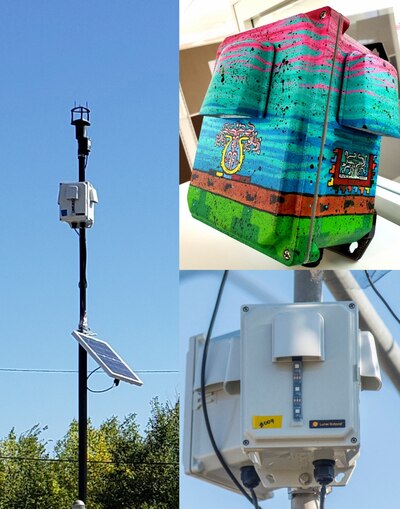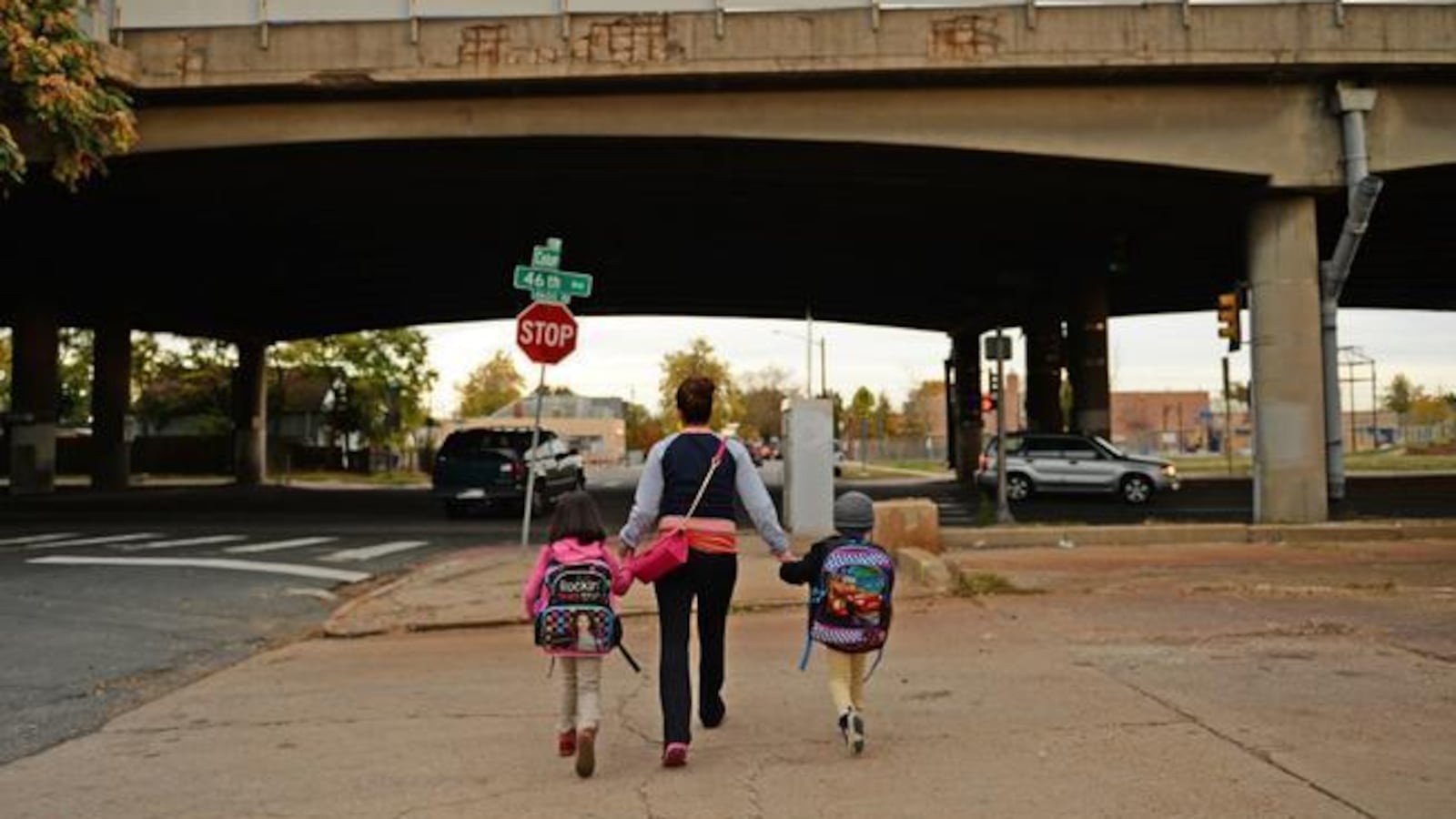For the first time, parents, teachers, and administrators at 10 Denver public schools will know just how much air pollution students are exposed to on campus any given day.
City leaders are deploying highly localized air quality sensors with the goals of empowering schools to make healthier choices for their students and reducing asthma rates. The data from the first 10 schools will come online next month, and the grant-funded sensors should be rolled out at an additional 30 city schools by 2021.

In the short term, schools could opt to keep students inside on a poorer air quality days, shift recess hours, or encourage parents not to keep their cars running while waiting in the carpool lane. Longer-term possibilities could involve moving the location of a playground farther from a busy street, or working with the city government to alter construction times, or to change truck and bus routes. But in the short-term, at least, Denver Public Schools has no plans to require schools to take action on high-pollution days. That will be up to individual principals, which is raising questions about whether the sensors, and their data, will have the intended effects, including reducing health-related absenteeism.
“The district has to enforce that, in every school, to keep kids safe, because if they don’t, if they leave it to each individual school, they’re going to do whatever they want to do,” said Sandra Ruiz-Parrilla, a parent living near Interstate 70 in the Elyria neighborhood. “I think that’s really unfair for our kids.”
The grant proposal, meanwhile, explicitly lays out a goal of developing programs at all 10 pilot schools that would help reduce students’ exposure to harmful air. City and health officials have been actively assisting schools with creating these programs, expected to be in place by December, according to the grant. The City of Denver also has a long-term goal to implement 10 new city policies aimed at improving school air quality by 2021.
“It’s empowering the school communities to get data that they can actually do something with,” explained Christy Haas-Howard, the district’s school nurse. “So each school can make a decision based on what the air quality is at that time and at that specific place.”
The three-year program was made possible by a $1 million Bloomberg Mayors Challenge grant awarded to the city, but the grant application shows the total price tag for the project will exceed $2.5 million once sensors are in place at all 40 schools. City and state health departments, as well as additional philanthropies are projected to cover the extra $1.5 million in costs.
Documents associated with the grant acknowledge students in Denver’s lower-income communities are more burdened by air pollution than those in higher-income areas.
The 10 schools set to have the sensors up and running by the start of the school year are Swansea Elementary, Garden Place Elementary, Fairview Elementary, Sabin World Elementary, Gust Elementary, University Prep – Steele Street, South High School, Bruce Randolph School, High Tech Early College, and Prep Academy. City officials say those schools were chosen based on student asthma rates, the number of students eligible for subsidized lunches, a proxy for poverty, and principal willingness to participate. Check out our interactive map lower on this page to see where those schools are located.
To learn more about student asthma rates in DPS, and to find the asthma rate in your child’s school, click here.
The Colorado Department of Transportation’s plans to expand a 10-mile stretch of I-70 in northern Denver has put new attention on air quality concerns in certain parts of the city. Swansea Elementary’s playground sits right next to I-70 and Garden Place Elementary lies under the “mousetrap,” where I-25 and I-70 meet. Both schools serve mostly children from low-income families in communities that have been exposed to significant pollution for generations.
Ruiz-Parrilla pulled her daughter out of Swansea Elementary, just a few blocks from her home, because she was concerned about increased air pollution from the construction project. Next year, the girl will attend University Prep – Steele Street.
The state already monitors air quality at various locations, including at five sites near some of the schools receiving on-site sensors. But those state readings have not informed policy changes at the district or school level, according to Denver Public Schools Environmental Program Manager Joni Rix. The numbers are not site-specific, Rix said, and “the district doesn’t want to tell schools what they should do or what works for their community.”
The state monitors cost about $25,000 each and are more sophisticated than the sensors going to schools, which cost about $1,500 each. Both technologies measure for a pollutant called Particulate Matter (PM) 2.5, which is an extremely fine particle – 30 times smaller than a strand of hair – that can get deep into the lungs and cause severe health problems, such as asthma.
According to the Environmental Protection Agency, these particles can be hundreds of different chemicals, which are either “emitted directly from a source, such as construction sites, unpaved roads, fields, smokestacks or fires” or form as a result of chemical reactions from power plants, industries, and automobiles.
The EPA’s daily average limit for PM 2.5 is 35 micrograms per cubic meter. The World Health Organization, noting that such pollution can impact health even at low concentrations, has a threshold of 25 micrograms per cubic meter.
NYU School of Medicine professor Dr. George Thurston, who has studied the effects of air pollution for decades, said the EPA’s legal PM 2.5 limit is “too lax,” noting the daily limit should be only 12 micrograms per cubic meter, not 35.
“There is no safe threshold,” said Thurston. “It’s just like driving in a car. There is a legal speed limit, but it’s not going to guarantee anything.”
A recent Chalkbeat analysis of the state air quality data found pollutant levels recorded at state monitoring sites across Denver have exceeded limits set by the World Health Organization on 53 days over the past five years. Of those 53 days, 15 of them also saw levels exceeding the EPA’s legal limit. Nine of those 15 days were days when school was in session.
A state-run air-quality monitor operated at 4903 Acoma Street in Globeville, only 0.7 miles from Garden Place Elementary School, recorded levels well above the EPA’s less conservative legal limits several times in the last five years.
To see the exceedances at all of the state monitor locations in the Denver metro area, check out our interactive map.
There are currently no state-operated air quality monitors farther south in the city. That means schools such as Sabin World Elementary, Gust Elementary, and South High School will have accurate air quality data pertinent to their specific locations for the first time.
But for other schools located closer to the state monitors, researchers tell Chalkbeat that DPS could have been using that state data to inform both short-term policy decisions on poor air quality days, as well as long-term regulatory changes, such as modifying construction times or truck and bus routes, at the city level.
“PM 2.5 tends to be spread very broadly and evenly over large areas,” said Dr. Doug Brugge, professor and chair at the University of Connecticut School of Medicine. “There’s some variation, but probably most of the time, the local monitors at the school are going to have values that are not going to be dramatically different than what the regional monitors have.”
Brugge explained chronic exposure to PM 2.5 is known to cause asthma, and can also affect children’s brain development, making it harder for children to learn.
“There is evidence these particulate pollutants are associated with affecting neurological functions,” said Brugge. “If I were running a school, or a school system, I would be at least as concerned about that, with young children, as I would be about the asthma.”
In fact, two studies released earlier this year found that children who moved to a school downwind of a pollution source saw their test scores drop.
While the state monitors haven’t yet been used to inform policy decisions, officials say the data provided by these new sensors at schools will be difficult to ignore, because the sensors will send real-time results to user-friendly websites for school officials, parents, students, and community members to see. Some school principals plan to put those results on big-screen displays on campus.

However, some parents hope the district will do more to alert parents to potential dangers, such as sending information home with students, since not all parents have access to computers.
“What other approach does the district have to get that information to people?” Ruiz-Parrilla asked.
A Denver Public School spokesperson, Anna Alejo, said the district would be “working to increase understanding among all our families on the impacts of air quality to student health.”
As a community activist leading a new neighborhood organization in Elyria, Ruiz-Parrilla said she plans to invite DPS officials to the group’s next meeting to discuss the sensors, their data, and best air quality policy policy practices at city schools.
“We can all help each other,” Ruiz-Parrilla said. “Now that I know that about them leaving the policies up to each individual school, that’s something they have to deal with. This matter should be a concern of the whole city. It doesn’t stop here.”

